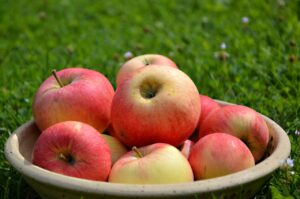
Glycemic Index Fruit Chart
Low GI Fruits (GI ≤ 55) – Best for Blood Sugar Control
| Fruit | GI Value | Remarks |
| Cherries | 20 | High in antioxidants |
| Grapefruit | 25 | Refreshing, high in vitamin C |
| Pears | 30–38 | Eat with skin for added fiber |
| Apples | 36–40 | Pair with peanut butter for a snack |
| Plums | 35 | Great as a snack, not overly sweet |
| Peaches | 42 | Rich in vitamin A |
| Strawberries | 41 | Low sugar, high in antioxidants |
| Oranges | 40–45 | Whole fruit better than juice |
| Apricots | 34 | Dried version has a much higher GI |
| Kiwis | 50 | Good vitamin C source |
| Grapes | 50–55 | Watch portion sizes |
Medium GI Fruits (GI 56–69) – Eat in Moderation
| Fruit | GI Value | Remarks |
| Mango | 56–60 | Nutrient-rich, enjoy in small portions |
| Bananas | 58 | Less ripe = lower GI |
| Papaya | 60 | Anti-inflammatory, rich in enzymes |
| Raisins | 64 | High in sugar; better mixed with nuts |
| Pineapple | 66 | High in vitamin C, quick to digest |
| Figs | 61 | Fresh figs better than dried |
High GI Fruits (GI ≥ 70) – Limit Intake
| Fruit | GI Value | Remarks |
| Watermelon | 72 | High water content; low carb per serving |
| Dates | 75 | Nutrient-dense but sugary |
| Dried fruit mixes | 80+ | Very concentrated sugars |
Top 10 Most Nutritious Fruits in the World
1. Apples
Nutrition Highlights:
- Fiber, especially pectin (supports gut health)
- Vitamin C
- Flavonoids (quercetin)
Apples are widely available and versatile. The phrase “an apple a day keeps the doctor away” exists for a reason—they support heart health, aid digestion, and may reduce cancer risk.
2.Kiwi
Nutrition Highlights:
- More vitamin C than oranges
- Potassium and vitamin K
- Fiber and antioxidants (lutein, zeaxanthin)
Kiwi is small but mighty. It boosts immunity, improves digestion, and supports eye health.
3.Guava
Nutrition Highlights:
- Extremely high in vitamin C (4x an orange!)
- Vitamin A, folate, and fiber
- Antibacterial and anti-inflammatory properties
Guava is a tropical powerhouse fruit that supports immunity, skin health, and digestion. It’s also excellent for blood sugar management.
4. Blueberries
Nutrition Highlights:
- Among the highest in antioxidants (anthocyanins)
- Vitamin C, K, and fiber
- Brain-boosting and anti-aging benefits
Blueberries are proven to improve memory, reduce inflammation, and fight oxidative stress. They’re often called the “king of antioxidants.”
5. Papaya
Nutrition Highlights:
- Vitamin C, folate, and fiber
- Enzymes like papain (aids digestion)
- Beta-carotene and lycopene
Papaya is excellent for gut health and inflammation. It’s gentle on the stomach and rich in compounds that support heart and skin health.
6. Avocado
Nutrition Highlights:
- Healthy monounsaturated fats (heart-friendly)
- Potassium, fiber, B-vitamins, and folate
- Low sugar content
Technically a fruit, avocado is in a class of its own. It’s ideal for brain, heart, and skin health, and supports weight management due to its healthy fats and fiber.
7.Pomegranate
Nutrition Highlights:
- Powerful antioxidants (punicalagins, anthocyanins)
- Vitamin C, potassium, and fiber
- Anti-inflammatory and anti-cancer properties
Pomegranate is one of the most antioxidant-rich fruits in the world. It’s linked to lower blood pressure, improved heart health, and even cancer prevention.
8.Oranges
Nutrition Highlights:
- Vitamin C, potassium, and fiber
- Flavonoids (hesperidin)
- Supports hydration and immunity
Oranges are a staple for immunity, but they also help reduce inflammation, support heart health, and provide hydration due to their high water content.
9. Acai Berries
Nutrition Highlights:
- Extremely high in antioxidants (more than blueberries)
- Healthy fats (omega-9, omega-6)
- Low in sugar
Acai is often considered a “superfruit.” Its antioxidant profile fights aging, inflammation, and oxidative stress. Though less available fresh, it’s popular in frozen or powder form.
FAQ
Q.What Is the Glycemic Index?
Ans: The glycemic index (GI) is a scale from 0 to 100 that ranks how quickly carbohydrate-containing foods raise blood sugar levels after eating.
- Low GI (1–55): Slowly digested, minimal blood sugar spike
- Medium GI (56–69): Moderate impact on blood sugar
- High GI (70+): Rapid blood sugar spike
Q. Why Fruits Have Different Glycemic Index Values
Ans: Several factors influence how fast fruit raises your blood sugar:
- Sugar type: Fructose has a lower GI than glucose.
- Fiber content: More fiber = slower digestion = lower GI.
- Ripeness: Riper fruits tend to have a higher GI.
- Processing: Juicing or drying increases GI significantly.